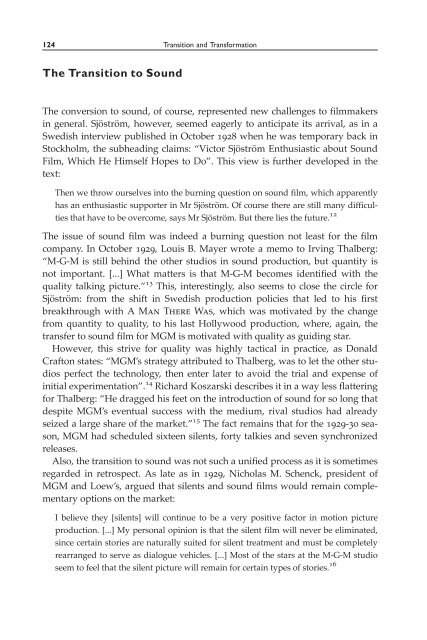FILM FILM - University of Macau Library
FILM FILM - University of Macau Library
FILM FILM - University of Macau Library
Create successful ePaper yourself
Turn your PDF publications into a flip-book with our unique Google optimized e-Paper software.
124 Transition and Transformation<br />
The Transition to Sound<br />
The conversion to sound, <strong>of</strong> course, represented new challenges to filmmakers<br />
in general. Sjöström, however, seemed eagerly to anticipate its arrival, as in a<br />
Swedish interview published in October 1928 when he was temporary back in<br />
Stockholm, the subheading claims: “Victor Sjöström Enthusiastic about Sound<br />
Film, Which He Himself Hopes to Do”. This view is further developed in the<br />
text:<br />
Then we throw ourselves into the burning question on sound film, which apparently<br />
has an enthusiastic supporter in Mr Sjöström. Of course there are still many difficulties<br />
that have to be overcome, says Mr Sjöström. But there lies the future. 12<br />
The issue <strong>of</strong> sound film was indeed a burning question not least for the film<br />
company. In October 1929, Louis B. Mayer wrote a memo to Irving Thalberg:<br />
“M-G-M is still behind the other studios in sound production, but quantity is<br />
not important. [...] What matters is that M-G-M becomes identified with the<br />
quality talking picture.” 13 This, interestingly, also seems to close the circle for<br />
Sjöström: from the shift in Swedish production policies that led to his first<br />
breakthrough with A Man There Was, which was motivated by the change<br />
from quantity to quality, to his last Hollywood production, where, again, the<br />
transfer to sound film for MGM is motivated with quality as guiding star.<br />
However, this strive for quality was highly tactical in practice, as Donald<br />
Crafton states: “MGM’s strategy attributed to Thalberg, was to let the other studios<br />
perfect the technology, then enter later to avoid the trial and expense <strong>of</strong><br />
initial experimentation”. 14 Richard Koszarski describes it in a way less flattering<br />
for Thalberg: “He dragged his feet on the introduction <strong>of</strong> sound for so long that<br />
despite MGM’s eventual success with the medium, rival studios had already<br />
seized a large share <strong>of</strong> the market.” 15 The fact remains that for the 1929-30 season,<br />
MGM had scheduled sixteen silents, forty talkies and seven synchronized<br />
releases.<br />
Also, the transition to sound was not such a unified process as it is sometimes<br />
regarded in retrospect. As late as in 1929, Nicholas M. Schenck, president <strong>of</strong><br />
MGM and Loew’s, argued that silents and sound films would remain complementary<br />
options on the market:<br />
I believe they [silents] will continue to be a very positive factor in motion picture<br />
production. [...] My personal opinion is that the silent film will never be eliminated,<br />
since certain stories are naturally suited for silent treatment and must be completely<br />
rearranged to serve as dialogue vehicles. [...] Most <strong>of</strong> the stars at the M-G-M studio<br />
seem to feel that the silent picture will remain for certain types <strong>of</strong> stories. 16

















